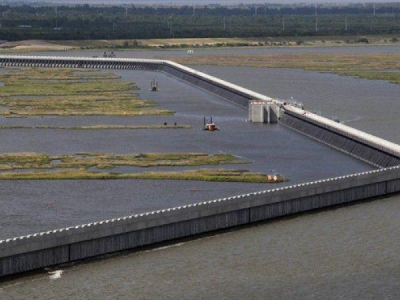
Posted on July 19, 2020
Louisiana may significantly trim the $100 million annual bill it pays to cover its share of the $14.6 billion post-Katrina New Orleans area hurricane protection system if a gambit by the state’s congressional delegation to require the Army Corps of Engineers to renegotiate the state’s terms is successful.
On Wednesday, a House Transportation subcommittee agreed to include a renegotiation requirement authored by Rep. Garret Graves, R-Baton Rouge, in the House version of the 2020 Water Resources Development Act, which includes various projects overseen by the Corps. The provision also was supported by House Minority Whip Steve Scalise, R-Jefferson, and Rep. Cedric Richmond, D-New Orleans.
The amendment was written specifically to cover the New Orleans levee project. It would allow the Corps to consider allowing the state to pay its share of the levee costs without interest, allow the Corps to forgive all or part of the interest accrued during construction, or give the state credit for investments “that benefit the completion or performance of the project.”
A draft Senate version of the same bill includes a slightly different renegotiation requirement that is supported by Sens. John Kennedy, R-La., and Bill Cassidy, R-La.
Congress agreed to pay Louisiana’s $1.1 billion share of the construction costs after the state and the Corps signed an agreement committing the state to repay that money over 30 years, with interest, beginning when construction of the levees were complete.
When construction on the levees began after Katrina, President George W. Bush set a 2010 deadline for their completion. That deadline was extended to 2011 by President Barack Obama, but a variety of delays, including in raising earthen levees to allow their armoring with plastic fabric, have resulted in the completion now being rescheduled for July 2021.
At the time of the 2009 agreement with the Corps, it used the 2011 completion date, and required the state to pay interest at two different rates, one for the construction period and the other for the 30-year repayment period, based on 2011 interest rates.
The state’s repayments will only begin after the Corps formally turns over ownership of the two levee systems to the state Coastal Protection Authority.
The state plans on issuing bonds during the two years after the levees are accepted as complete to provide a steady stream of revenue for the repayments. CPRA officials have in the past suggested that at least some of the annual repayment cost would come from revenue the state receives from federal offshore oil revenue, but has said it would rather use that money on other levee and restoration projects. It also is looking at including the annual cost in the state’s annual capitol budget.
CPRA officials have not suggested that asking the east or west bank levee authorities to pay a share of the construction costs is an alternative for repaying the construction costs, though operation and maintenance costs of the levee system are built into the regional authority budgets and are paid for by local taxpayers in the New Orleans area.
The state has made it clear that it will accept the projects only after it determines that the construction is complete and meets the design requirements for individual levee segments. That’s expected to occur in July 2021 for the east bank levees, and September 2021 for the west bank levees.
The state Coastal Protection and Restoration Authority has estimated the state will have to pay more than $568 million in interest alone on its share of the construction costs. It estimates the state would pay another $1.3 billion in interest charges during the 30-year payback period.
That means the state will pay a total of more than $1.8 billion in interest, equal to 160% of the state’s share of construction costs and 62% of the state’s total bill.
In a briefing document, the CPRA argued that the Corps should allow money the state spends on restoration projects to be substituted for the interest payments — especially in light of the 10 years of construction delays, which have reduced the levees’ efficacy.
“In addition to close to a decade of delays, Louisiana’s Coastal Master Plan projects would benefit over 272,000 acres of land that will add resiliency to the (levee system), extend its lifespan, and avoid damages to assets inside the system,” the state report said.
“Coastal infrastructure is essential for the preservation of life and inland communities and infrastructure. By giving the state relief on the interest associated with this debt, it will allow for more investments from the state toward coastal restoration and green infrastructure projects that will protect the federal investment in the (levee system),” it said.
The state might also argue that, if interest is required by the Corps, it should be paid at today’s much lower interest rates.
The Water Resources Development Act must still be approved by the full House and by the Senate, a process likely to take until an expected October recess by Congress.
It’s unclear whether the legislation would be considered during what will be a “lame duck” session of Congress between the November elections and the beginning of new congressional terms in January 2021.
Mark Schleifstein covers the environment and is a leader of the Louisiana Coastal Reporting Team for The Times-Picayune | The New Orleans Advocate. Email: mschleifstein@theadvocate.com. Facebook: Mark Schleifstein and Louisiana Coastal Watch. Twitter: MSchleifstein.
Source: nola.com





